基于相变材料Ge2Sb2Se4Te1的可切换边缘检测与聚焦成像超表面
1 引言
图像处理在许多技术领域有着不可替代的作用。起初,图像处理的方法主要是通过集成电路在数字领域进行数学运算,但该方法运算速度慢、功耗高,限制了其进一步的应用[1-2]。为了解决这些问题,Solli 等[3]在2015年提出了基于光学器件的光模拟计算方法。这种方法通过操纵携带图像信息的光信号来进行图像处理。虽然通过光学模拟计算,图像处理可以更快更有效,但通常需要庞大的光学仪器配制[4],这不适用于高集成度的现代光学系统。最近,一种二维亚波长结构—超表面,凭借对电磁波的偏振、振幅和相位的控制能力[5-16]引起了广泛的关注。在过去的几年里,许多基于超表面的新方法被提出用于各种光学元件和系统,包括全息图[17-21]、 光束整形[22-23],次级衍射成像[24-25]、电磁隐身[26-27]等等。 与此同时,超表面也作为边缘检测中的空间微分器被用于光学模拟计算类的图像处理[28-30]。近年来,有一些研究利用精细设计的超表面结构实现了二维边缘检测[31-34]。Huo 等[33] 基于超表面与4f 成像系统的结合,通过切换入射光的偏振态实现了边缘检测与明场成像之间的动态切换,提取了物体上的不同形态信息,扩展了超表面的应用场景;He 等[34]演示了无需4f 成像系统的二维边缘检测,进一步提高了超表面的集成度。
尽管相关研究已经取得相当大的进展,但上述超表面在本质上仍然是静态的,其光学性质在制造完成时就已固定,不利于超表面的进一步应用。因此,越来越多的研究聚焦于主动调控超表面。在此过程中,相变材料是超表面动态控制中非常重要的一部分。迄今为止,已有多种不同的调制方法被运用研究各种功能材料,如导电氧化物、石墨烯、液晶和相变材料(PCMs)[35]。其中,Ge2Sb2Te5(GST)是一种典型的相变材料,由于其在外界刺激下由晶态转变为非晶态时折射率差异较大而得到了广泛的应用[36-37]。并且,GST的晶态和非晶态在室温下稳定,具有高折射率差异和更快的开关速度[38-42]。但晶态GST在红外光范围内的光学损耗限制了它的应用。近年,通过将GST中的Te原子替换为Se原子,出现了一种新的相变材料Ge2Sb2Se4Te1(GSST)。与GST相比,GSST不仅具有上述优点,并且在红外光谱范围内的光学损耗极低[43]。
基于上述背景,本文提出了一种基于GSST的单片超表面,在不需要4f 成像系统辅助的情况下,可实现边缘检测与聚焦成像之间的动态切换。超表面被设计在两种结晶状态下实现两种不同的图像处理机制。通过不同结晶态下的传输相位和几何相位组合,左旋圆偏振光束和右旋圆偏振光束(下文简称LCP光和RCP光)将携带不同的相位。通过优化这些相位,可以分别实现边缘检测和聚焦成像两种功能。
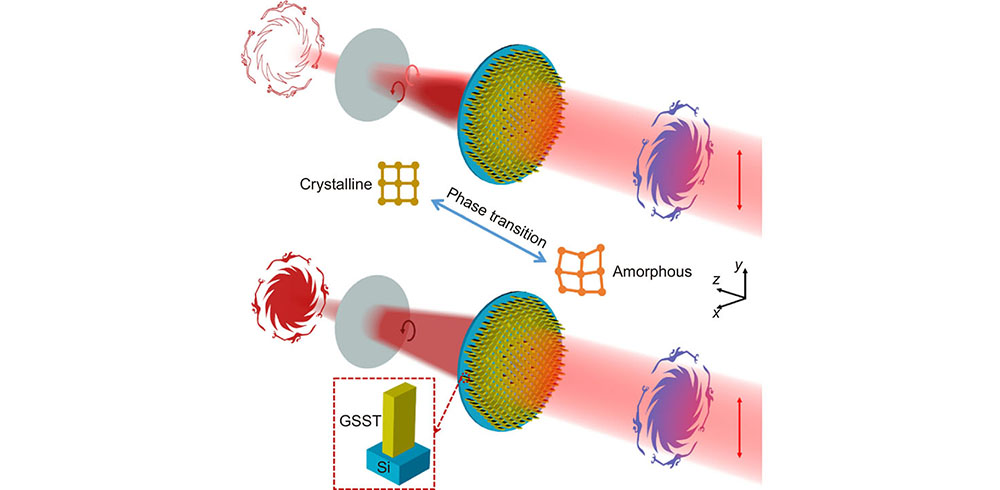
图 1. 基于GSST相变实现边缘检测和聚焦成像间动态切换的超表面原理图
Fig. 1. Schematic of the metasurface platform enables dynamic switching between the edge detection and imaging based on the phase transition of GSST
2 单元结构设计与梯度超表面仿真
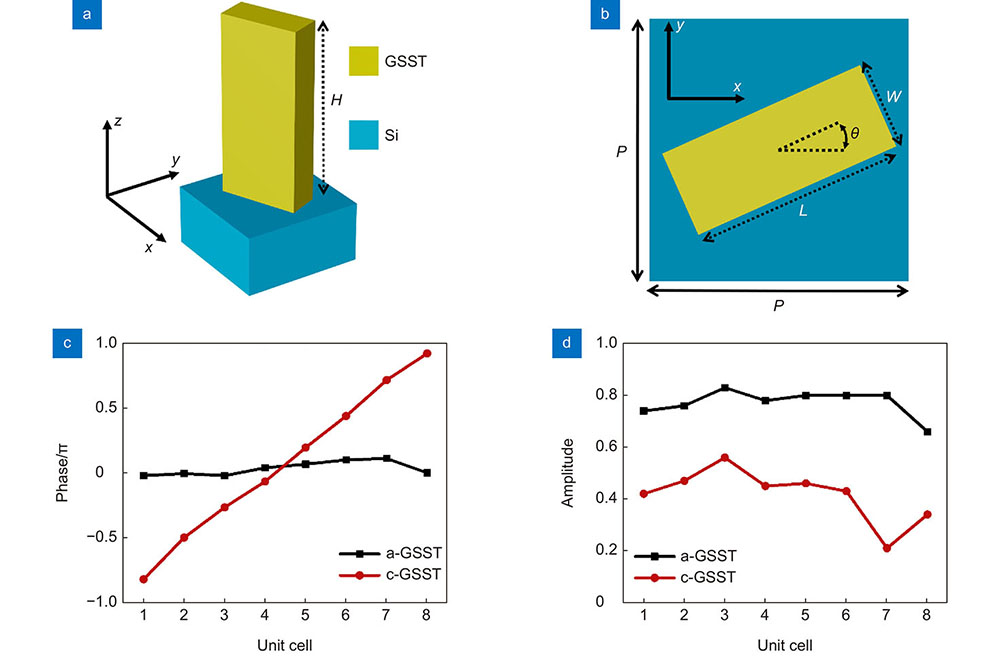
图 2. (a, b) 不同视图下的单元结构示意图;(c, d) 10.6 μm波长下八个单元结构的相位响应和交叉偏振系数。方柱结构和基底的材料分别是GSST和Si。恒定参数(高度、周期):H = 6 μm, P = 4 μm;八个单元结构的长度(L)和宽度(W)分别为L= 2.9 μm,3.0 μm,3.3 μm,3.2 μm,3.5 μm,3.79 μm,3.82 μm和2.68 μm,W= 1.34 μm,1.28 μm,1.2 μm,1.14 μm,1.0 μm,0.83 μm,0.8 μm和1.41 μm
Fig. 2. (a, b) Schematic illustrations of unit cells at different views. (c, d) Simulated phase responses and cross-polarized coefficients of eight unit cells for circularly polarized light at the wavelength of 10.6 μm. The materials of nanofins and substrate are GSST and Si, respectively. Constant parameters: H = 6 μm, P = 4 μm. The length (L) and width (W) of eight unit cells are L= 2.9, 3.0, 3.3, 3.2, 3.5, 3.79, 3.82 and 2.68 μm, W= 1.34, 1.28, 1.2, 1.14, 1.0, 0.83, 0.8 and 1.41 μm
基于上述结论,本文优化设计了一组实现可调控SOIs的单元结构。不同单元结构的电磁响应在CST微波工作室频域求解器中使用有限积分技术进行了模拟计算,其中边界条件x和y方向设置为unit cell,z方向设置为open;入射波波长为10 μm~11 μm。
为了证明该设计的通用性和有效性,在CST微波工作室时域求解器中使用有限积分技术(FIT)模拟计算了透射光在GSST不同结晶态下的异常折射。其中边界条件x和y方向设置为periodic,z方向设置为open;并设置了足够的网格单元用以捕捉场分布,减少误差。入射光源采用波长为10.6 μm 的圆偏振光。
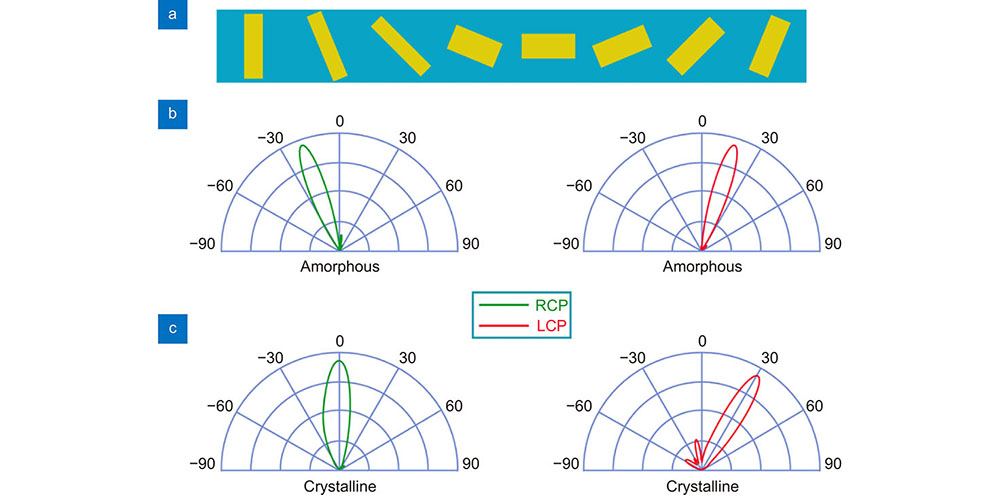
图 3. (a) 可调谐异常透射梯度超表面周期结构示意图;(b) a-GSST下的模拟交叉偏振远场分布;(c) c-GSST下的模拟交叉偏振远场分布
Fig. 3. (a) Schematic illustration of a periodic gradient metasurface for tunable anomalous transmission; (b) The simulated cross-polarized far-field distributions when GSST is amorphous; (c) The simulated cross-polarized far-field distributions when GSST is crystalline
3 成像功能分析设计与验证
为了实现可切换边缘检测与聚焦成像单片超表面,下面对两者原理进行简单分析。首先,对于聚焦成像,相位分布ψ与坐标x和y之间的关系为
其中:λ是入射光波长; f 是焦距。
与聚焦成像相比,边缘检测的机理更为复杂。为了方便起见,先对一维边缘成像的工作原理进行分析。在携带物体信息的线偏振光的照射下,具有几何相位梯度分布的超表面投射出具有对称折射的LCP和RCP光,导致LCP和RCP图像分别发生横向偏移±l。因此电场可表示为
当l远小于成像尺寸时,LCP光和RCP光在同一点上的相位可视为是相等的。因此,LCP和RCP图像的重叠区域将会保持入射时的偏振态,用正交线性偏振器进行滤波,最终的电场可以改写为
由于与整个成像相比,l可以忽略。 因此,
因此,边缘检测的关键过程就简单地分为成像、分离和过滤三个步骤[48]。为了同时实现成像和分离,两相分布应表示为
其中:λ 是入射波长; f 是焦距;σ =±1(对于LCP和RCP光,σ分别等于+1和−1);n 是一个控制LCP和RCP图像分离程度的变量实数,n的大小与分离程度成反比。因此,边缘宽度取决于选定的n值和所设计超表面的衍射极限。对于二维边缘检测,分离过程拓展为LCP和RCP图像沿着径向等比例缩小和放大,利用正交线性偏振器进行滤波。因此,同时进行成像、分离是实现边缘检测的重点。通过分析和优化,单元结构在c-GSST的传输相位和偏转角分布设计如下:
其中:φc(x,y)是晶态下的(x,y)坐标处相位,θ (x,y)为对应坐标处单元结构旋转角度,rmax是圆形超表面的半径,f1 和 f2 分别是边缘检测和聚焦成像的焦距。采用这种设计方法,在a-GSST下,超表面对LCP和RCP透射光赋予的总相位由相同的传输相位和相反的几何相位组成,因此 LCP光会获得聚焦相位,RCP光会获得相反的发散相位,因而利用LCP光可实现焦距为f2聚焦成像。在c-GSST下,超表面的传输相位为聚焦相位,几何相位会分别在该聚焦相位的基础上叠加一个聚焦相位和发散相位,当f2满足式(8)时,该叠加相位可以将LCP和RCP图像沿着径向等比例缩小和放大,从而实现焦距为f1的边缘检测。
最后,为验证式(6)和式(7)分布设计的可行性,建立了相应的超表面模型。超表面由30×30个单元结构组成,尺寸为120 μm ×120 μm,相关参数分别为λ=10.6 μm,rmax=60 μm,f1=100 μm,f2=1000 μm;c-GSST和a-GSST的折射率n分别为4.16和3.18,底层材料硅(Si)的折射率n=3.42;GSST方柱高度H=6 μm。在CST微波工作室时域求解器中使用有限积分技术进行了模拟仿真。模拟仿真目标分布应为圆环形(焦点边缘)和圆点形(聚焦焦点)分布,模拟仿真结果如
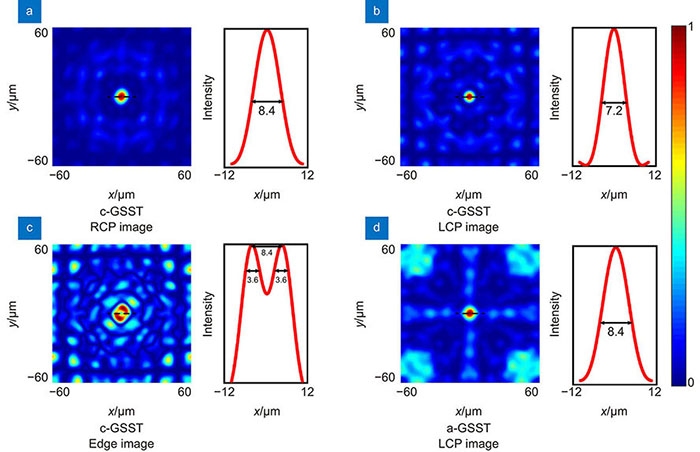
图 4. 入射光为10.6 μm时GSST不同态下像面强度分布。(a) c-GSST下,z=100 μm时模拟RCP成像强度分布和中心虚线部分归一化强度分布;(b) c-GSST下,z=100 μm时模拟LCP成像强度分布和中心虚线部分归一化强度分布;(c) c-GSST下,z=100 μm时模拟偏振滤波后的像面强度分布和中心虚线部分归一化强度分布;(d) a-GSST下,z=1000 μm时模拟聚焦成像强度分布和中心虚线部分归一化强度分布
Fig. 4. The simulated image intensity distributions of different states under the 10.6 μm incident beam. (a) The simulated RCP image intensity distributions and normalized intensity distributions of the dotted line on z=100 μm plane when GSST is crystalline; (b) The simulated LCP image intensity distributions and normalized intensity distributions of the dotted line on z=100 μm plane when GSST is crystalline; (c) The simulated edge image intensity distribution and normalized intensity distributions of the dotted line on z=100 μm plane when GSST is crystalline; (d) The simulated LCP image intensity distribution and normalized intensity distributions of the dotted line on z=1000 μm plane when GSST is amorphousSST is amorphous
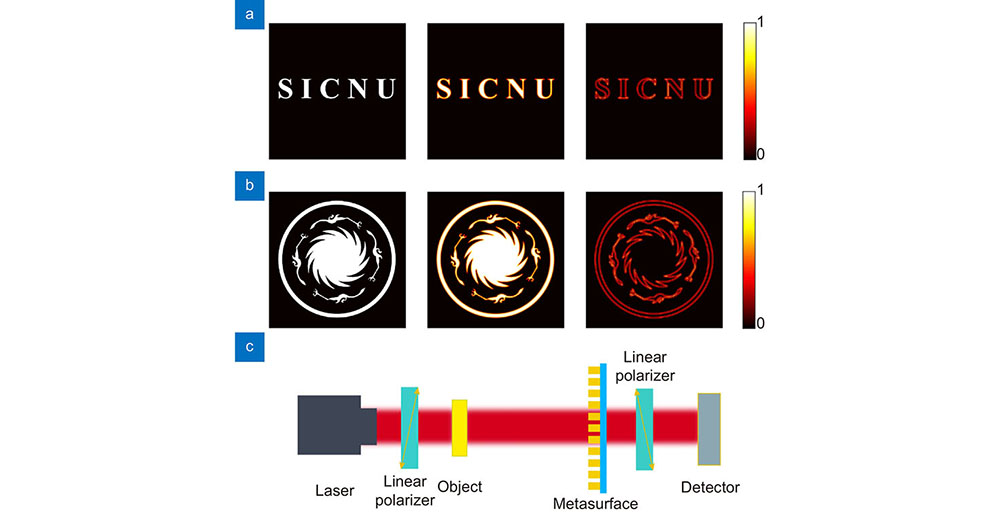
图 5. (a) 理论模拟计算成像物体为“S I C N U”字母时,从左到右依次为:物体图像,聚焦成像,边缘检测成像; (b) 理论模拟计算成像物体为太阳神鸟时,从左到右依次为:物体图像,聚焦成像,边缘检测成像;(c) 图像处理系统示意图
Fig. 5. (a) The calculation results when the object is "S I C N U", from left to right: object image, imaging, edge detection imaging; (b) The calculation results when the object is the sun and immortal birds, from left to right: object image, imaging, and edge detection imaging; (c) Schematic illustration of the system for image processing
4 结论
综上所述,本文提出了一种可切换聚焦成像与边缘检测的单片超表面,超表面由基于GSST相变材料的单元结构组成。基于GSST的单元结构通过GSST的结晶态转换实现了可切换光子SOIs。并通过利用可切换光子SOIs的特性设计了可切换边缘检测与聚焦成像超表面。最后通过模拟仿真和理论计算验证了该设计的可行性。本文提出的超表面无需4f 成像系统的辅助,进一步提高了超表面应用的集成度,为有源元器件的设计提供了新的思路,在生物医学成像和缺陷检测等领域有潜在应用价值。
Overview: This paper is devoted to the research of switchable edge detection and imaging metasurface without a 4f system. Edge detection and imaging both are important parts of modern imaging processing, which are widely applied in the fields of robot vision, modern artificial intelligence, and medical imaging operation. The method of processing images based on mathematical operations usually has low operational speed and high-power consumption. Therefore, optical analog computation is suggested to operate image processing performs by manipulating optical signal carrying image information. Optical analog computation based on the traditional optical system needs bulky configurations which is improper in highly integrated modern optical systems. Therefore, this paper analyzes and designs the phase distribution which enable switchable edge detection and imaging and proved the feasibility of the design by operating simulation and theoretical calculation with the proposed metasurface. The switchable ability relies on the switchable photonic spin-orbit interactions (SOIs). Therefore, firstly this paper described and analyzed SOIs. And then we utilize two optical properties of GSST in crystalline and amorphous states to design eight unit cells which have different phases when GSST is in different states. In order to prove that the switchable SOIs can be realized by using the free combination of the proposed eight unit cells, the gradient metasurface consists of unit cells designed to perform symmetric photonic SOIs when GSST is in the amorphous state, resulting in symmetric refractive angles -17.1° and 17.1° for LCP and RCP incidence. While the designed gradient metasurface performs asymmetric photonic SOIs when GSST is in the crystalline state, resulting in refractive angles of 0° and 32° for LCP and RCP incidence. The simulated refractive angles are approximately-19.5°, 17.7° and 0°, 31.2° in the amorphous and crystalline state. The highly consistent results between simulation and theoretical calculation prove the feasibility of this design. Then the principle of imaging and edge detection is analyzed theoretically, and by analyzing and optimizing legitimately, designed the propagation phase at the crystalline state and orientation angle for the unit cells. Employing this design method, when GSST is in the amorphous state the phase of transmitted LCP light fulfills the focusing phase. When GSST is in the crystalline state, the transmitted wavefronts of LCP and RCP can match the phase distributions of edge detection. Further, in order to prove the feasibility of the designed metasurface, a metasurface model is created to operate edge detection and imaging in CST Microwave Studio. The edge imaging of the object and the object imaging in simulated results proved the feasibility of the designed metasurface. Finally, at the same time, the letters "S I C N U" and the sun and immortal birds are chosen as objects for calculating the imaging of complex objects theoretically under the above-mentioned phase distributions. The theoretic edge imaging and imaging of the letters "S I C N U" and the sun and immortal birds proved that designed two-phase distributions can realize edge detection and bright-field imaging well. To sum up, the metasurface designed in this paper can provide a kind of design without a 4f system to realize switchable edge detection and imaging.
[1] Kwon H, Sounas D, Cordaro A, et al. Nonlocal metasurfaces for optical signal processing[J]. Phys Rev Lett, 2018, 121(17): 173004.
[2] Davis T J, Eftekhari F, Gómez D E, et al. Metasurfaces with asymmetric optical transfer functions for optical signal processing[J]. Phys Rev Lett, 2019, 123(1): 013901.
[3] Solli D R, Jalali B. Analog optical computing[J]. Nat Photonics, 2015, 9(11): 704-706.
[4] Zhu T F, Lou Y J, Zhou Y H, et al. Generalized spatial differentiation from the spin hall effect of light and its application in image processing of edge detection[J]. Phys Rev Appl, 2019, 11(3): 034043.
[5] Mueller J P B, Rubin N A, Devlin R C, et al. Metasurface polarization optics: independent phase control of arbitrary orthogonal states of polarization[J]. Phys Rev Lett, 2017, 118(11): 113901.
[6] Chen W T, Zhu A Y, Capasso F. Flat optics with dispersion-engineered metasurfaces[J]. Nat Rev Mater, 2020, 5(8): 604-620.
[7] Huang Y J, Xiao T X, Xie Z W, et al. Single-layered phase-change metasurfaces achieving efficient wavefront manipulation and reversible chiral transmission[J]. Opt Express, 2022, 30(2): 1337-1350.
[8] Huang Y J, Xiao T X, Xie Z W, et al. Multistate nonvolatile metamirrors with tunable optical chirality[J]. ACS Appl Mater Interfaces, 2021, 13(38): 45890-45897.
[9] Huang Y J, Xiao T X, Xie Z W, et al. Single-layered reflective metasurface achieving simultaneous spin-selective perfect absorption and efficient wavefront manipulation[J]. Adv Opt Mater, 2021, 9(5): 2001663.
[10] Zhang Y X, Pu M B, Jin J J, et al. Crosstalk-free achromatic full Stokes imaging polarimetry metasurface enabled by polarization-dependent phase optimization[J]. Opto-Electron Adv, 2022, 5(11): 220058.
[11] Li J T, Wang G C, Yue Z, et al. Dynamic phase assembled terahertz metalens for reversible conversion between linear polarization and arbitrary circular polarization[J]. Opto-Electron Adv, 2022, 5(1): 210062.
[12] Wang Y L, Fan Q B, Xu T. Design of high efficiency achromatic metalens with large operation bandwidth using bilayer architecture[J]. Opto-Electron Adv, 2021, 4(1): 200008.
[13] Yue Z, Li J T, Li J, et al. Terahertz metasurface zone plates with arbitrary polarizations to a fixed polarization conversion[J]. Opto-Electron Sci, 2022, 1(3): 210014.
[14] 蓝翔, 邓钦荣, 张汶婷, 等. 基于扭转悬链线结构的高效手性吸波器[J]. 光电工程, 2022, 49(10): 220157.
Lan X, Deng Q R, Zhang W T, et al. Efficient chiral absorber based on twisted catenary structure[J]. Opto-Electron Eng, 2022, 49(10): 220157.
[15] 杨睿, 于千茜, 潘一苇, 等. 基于片上超表面的多路方向复用全息术[J]. 光电工程, 2022, 49(10): 220177.
Yang R, Yu Q Q, Pan Y W, et al. Directional-multiplexing holography by on-chip metasurface[J]. Opto-Electron Eng, 2022, 49(10): 220177.
[16] Huang Y J, Xiao T X, Chen S, et al. All-optical controlled-NOT logic gate achieving directional asymmetric transmission based on metasurface doublet[J]. Opto-Electron Adv, 2023, 6: 220073.
[17] Zheng G X, Mühlenbernd H, Kenney M, et al. Metasurface holograms reaching 80% efficiency[J]. Nat Nanotechnol, 2015, 10(4): 308-312.
[18] Li X, Chen L W, Li Y, et al. Multicolor 3D meta-holography by broadband plasmonic modulation[J]. Sci Adv, 2016, 2(11): e1601102.
[19] Xie X, Liu K P, Pu M B, et al. All-metallic geometric metasurfaces for broadband and high-efficiency wavefront manipulation[J]. Nanophotonics, 2020, 9(10): 3209-3215.
[20] Tang Z Y, Li L, Zhang H C, et al. Multifunctional Janus metasurfaces achieving arbitrary wavefront manipulation at dual frequency[J]. Mater Des, 2022, 223: 111264.
[21] 许可, 王星儿, 范旭浩, 等. 超表面全息术: 从概念到实现[J]. 光电工程, 2022, 49(10): 220183.
Xu K, Wang X E, Fan X H, et al. Meta-holography: from concept to realization[J]. Opto-Electron Eng, 2022, 49(10): 220183.
[22] Devlin R C, Ambrosio A, Rubin N A, et al. Arbitrary spin-to–orbital angular momentum conversion of light[J]. Science, 2017, 358(6365): 896-901.
[23] Li Q T, Dong F L, Wang B, et al. Free-space optical beam tapping with an all-silica metasurface[J]. ACS Photonics, 2017, 4(10): 2544-2549.
[24] Chen W T, Zhu A Y, Sanjeev V, et al. A broadband achromatic metalens for focusing and imaging in the visible[J]. Nat Nanotechnol, 2018, 13(3): 220-226.
[25] Wang S M, Wu P C, Su V C, et al. A broadband achromatic metalens in the visible[J]. Nat Nanotechnol, 2018, 13(3): 227-232.
[26] Cai W S, Chettiar U K, Kildishev A V, et al. Optical cloaking with metamaterials[J]. Nat Photonics, 2007, 1(4): 224-227.
[27] Xie X, Li X, Pu M B, et al. Plasmonic metasurfaces for simultaneous thermal infrared invisibility and holographic illusion[J]. Adv Funct Mater, 2018, 28(14): 1706673.
[28] Zhou Y, Wu W H, Chen R, et al. Analog optical spatial differentiators based on dielectric metasurfaces[J]. Adv Opt Mater, 2020, 8(4): 1901523.
[29] Cordaro A, Kwon H, Sounas D, et al. High-index dielectric metasurfaces performing mathematical operations[J]. Nano Lett, 2019, 19(12): 8418-8423.
[30] Dong Z W, Si J N, Yu X Y, et al. Optical spatial differentiator based on subwavelength high-contrast gratings[J]. Appl Phys Lett, 2018, 112(18): 181102.
[31] Zhou Y, Zheng H Y, Kravchenko I I, et al. Flat optics for image differentiation[J]. Nat Photonics, 2020, 14(5): 316-323.
[32] Wan L, Pan D P, Yang S F, et al. Optical analog computing of spatial differentiation and edge detection with dielectric metasurfaces[J]. Opt Lett, 2020, 45(7): 2070-2073.
[33] Huo P C, Zhang C, Zhu W Q, et al. Photonic spin-multiplexing metasurface for switchable spiral phase contrast imaging[J]. Nano Lett, 2020, 20(4): 2791-2798.
[34] He Q, Zhang F, Pu M B, et al. Monolithic metasurface spatial differentiator enabled by asymmetric photonic spin-orbit interactions[J]. Nanophotonics, 2021, 10(1): 741-748.
[35] Shaltout A M, Shalaev V M, Brongersma M L. Spatiotemporal light control with active metasurfaces[J]. Science, 2019, 364(6441): eaat3100.
[36] Chang C M, Chu C H, Tseng M L, et al. Local electrical characterization of laser-recorded phase-change marks on amorphous Ge2Sb2Te5 thin films[J]. Opt Express, 2011, 19(10): 9492-9504.
[37] Chen Y G, Kao T S, Ng B, et al. Hybrid phase-change plasmonic crystals for active tuning of lattice resonances[J]. Opt Express, 2013, 21(11): 13691-13698.
[38] Yamada N. Origin, secret, and application of the ideal phase-change material GeSbTe[J]. Phys Status Solidi, 2012, 249(10): 1837-1842.
[39] Loke D, Lee T H, Wang W J, et al. Breaking the speed limits of phase-change memory[J]. Science, 2012, 336(6088): 1566-1569.
[40] Michel A K U, Zalden P, Chigrin D N, et al. Reversible optical switching of infrared antenna resonances with ultrathin phase-change layers using femtosecond laser pulses[J]. ACS Photonics, 2014, 1(9): 833-839.
[41] Wang Q, Rogers E T F, Gholipour B, et al. Optically reconfigurable metasurfaces and photonic devices based on phase change materials[J]. Nat Photonics, 2016, 10(1): 60-65.
[42] Du K K, Li Q, Lyu Y B, et al. Control over emissivity of zero-static-power thermal emitters based on phase-changing material GST[J]. Light Sci Appl, 2017, 6(1): e16194.
[43] Zhang Y F, Chou J B, Li J Y, et al. Broadband transparent optical phase change materials for high-performance nonvolatile photonics[J]. Nat Commun, 2019, 10(1): 4279.
[44] Arbabi A, Horie Y, Bagheri M, et al. Dielectric metasurfaces for complete control of phase and polarization with subwavelength spatial resolution and high transmission[J]. Nat Nanotechnol, 2015, 10(11): 937-943.
[45] Bliokh K Y, Rodríguez-Fortuño F J, Nori F, et al. Spin–orbit interactions of light[J]. Nat Photonics, 2015, 9(12): 796-808.
[46] Zhang F, Pu M B, Luo J, et al. Symmetry breaking of photonic spin‐orbit interactions in metasurfaces[J]. Opto-Electron Eng, 2017, 44(3): 319-325.
[47] Yang H, Xie Z W, He H R, et al. Switchable imaging between edge-enhanced and bright-field based on a phase-change metasurface[J]. Opt Lett, 2021, 46(15): 3741-3744.
[48] Zhou J X, Qian H L, Chen C F, et al. Optical edge detection based on high-efficiency dielectric metasurface[J]. Proc Natl Acad Sci USA, 2019, 116(23): 11137-11140.
Article Outline
胡杰, 唐紫依, 蓝翔, 邓钦荣, 张汶婷, 黄奕嘉, 李玲. 基于相变材料Ge2Sb2Se4Te1的可切换边缘检测与聚焦成像超表面[J]. 光电工程, 2023, 50(8): 220284. Jie Hu, Ziyi Tang, Xiang Lan, Qinrong Deng, Wenting Zhang, Yijia Huang, Ling Li. Switchable edge detection and imaging based on a phase-change metasurface with Ge2Sb2Se4Te1[J]. Opto-Electronic Engineering, 2023, 50(8): 220284.



